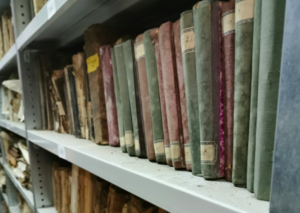The first Census of Italian Jewish books is here
 After the initial pilot phase, the digital census project of about thirty-five thousand Jewish-themed volumes, “Y-TAL-YA Books”, had officially started last summer. The project, conceived from a collaboration between the Union of Italian Jewish Communities – the institution in charge of the initiative – the National Central Library of Rome, the National Library of Israel and the Rothschild foundation, aims to create a bilingual database in Italian and Hebrew which will cover the entire period, from the origins of the press to the 1960’s. The survey was carried out on fourteen Jewish communities and twenty-five government bodies.
After the initial pilot phase, the digital census project of about thirty-five thousand Jewish-themed volumes, “Y-TAL-YA Books”, had officially started last summer. The project, conceived from a collaboration between the Union of Italian Jewish Communities – the institution in charge of the initiative – the National Central Library of Rome, the National Library of Israel and the Rothschild foundation, aims to create a bilingual database in Italian and Hebrew which will cover the entire period, from the origins of the press to the 1960’s. The survey was carried out on fourteen Jewish communities and twenty-five government bodies.
Andrea De Pasquale, director of the National Central Library of Rome and member of the administration council of the Jewish cultural Heritage Foundation in Italy, stressed in an essay the historical value of the project. “The realisation of a census that allows us to be aware of the Jewish Italian bibliographic heritage currently present in the communities and cultural institutions has always been hoped for, after the loss and destruction experienced during the last war” he writes on DigItalia Web, digital magazine on cultural heritage.
Until today, De Pasquale reminds us, “all attempts were thwarted”. Even in state libraries, many of which keep important Jewish archives, “the census projects were limited to traditionally well-known institutions and mostly to manuscripts, generally leaving out the books from after the seventeenth century”. De Pasquale refers particularly to the Palatina Library in Parma which preserves the archives belonging to the abbot Gian Bernardo De Rossi: archives include, “aside from extraordinary manuscripts, an exceptional collection of ancient editions, among which the only remaining copy of the most ancient text published in Hebrew characters with a certain date (Reggio Calabria, 1475) and the almost complete series of editions produced by the Soncino family, focus of the European project ‘Judaica Europeana’ concerning the digitalization of the incunabula and part of the sixteenth-century editions”.
Another reference is the National University Library in Turin, which preserves a collection of printed works “that constitutes a unique source for studying the history of Jewish typography”. A richness recently promoted in an exposition titled Judaica Pedemontana.
He also mentions “the numerous Jewish sixteenth-century editions present in the Casanatenese and Angelica libraries, subjects of printed catalogues, or the Lattes brothers’ collection at the Braidense National Library, which still lies there without specific descriptive tools”.
These are just some examples of an enormous heritage that will be rediscovered and valued.
Translated by Oyebuchi Lucia Leonard and revised by Silvia Bozzo, students at Trieste University and the Advanced school for interpreters and Translators of Trieste University, interns at the newspaper office of the Union of the Italian Jewish Communities.
